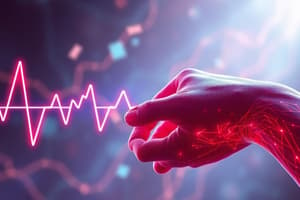Podcast
Questions and Answers
What is the primary mechanism for regulating the amount of calcium that enters the cell during depolarization?
What is the primary mechanism for regulating the amount of calcium that enters the cell during depolarization?
- Binding of norepinephrine to muscarinic receptors
- Inhibition of adenylyl cyclase
- Phosphorylation of the L-type calcium channel (correct)
- Hydrolysis of cAMP to ATP
Which receptor is primarily coupled to a specific stimulatory G-protein that activates adenylyl cyclase?
Which receptor is primarily coupled to a specific stimulatory G-protein that activates adenylyl cyclase?
- Beta-1 adrenoceptor (correct)
- Gi-protein
- Adenosine receptor A1
- M2 muscarinic receptor
What effect does the inhibitory G protein (Gi-protein) have on inotropy?
What effect does the inhibitory G protein (Gi-protein) have on inotropy?
- Increases inotropy
- Decreases inotropy (correct)
- Stimulates adenylyl cyclase
- No effect on inotropy
What is the primary function of cardiac myocytes?
What is the primary function of cardiac myocytes?
Where is the sinus (sinoatrial) node located?
Where is the sinus (sinoatrial) node located?
What is the resting membrane potential of the sinus nodal fiber between discharges?
What is the resting membrane potential of the sinus nodal fiber between discharges?
What is the term used to describe the fusion of cardiac myocytes resulting in a branching network of cells?
What is the term used to describe the fusion of cardiac myocytes resulting in a branching network of cells?
What serves as low resistance pathways between cardiac myocytes, permitting cell-to-cell conduction of electrical currents?
What serves as low resistance pathways between cardiac myocytes, permitting cell-to-cell conduction of electrical currents?
Which type of muscle has a branching network of cells sometimes referred to as a functional syncytium?
Which type of muscle has a branching network of cells sometimes referred to as a functional syncytium?
What are the specialized cell membranes that connect individual cardiac myocytes to each other?
What are the specialized cell membranes that connect individual cardiac myocytes to each other?
Which type of muscle shares some structural and functional similarities with cardiac muscle?
Which type of muscle shares some structural and functional similarities with cardiac muscle?
What ensures that an electrical impulse will travel to all interconnected cardiac myocytes when one myocyte is electrically stimulated?
What ensures that an electrical impulse will travel to all interconnected cardiac myocytes when one myocyte is electrically stimulated?
What causes the rapid upstroke spike of the action potential observed in ventricular muscle?
What causes the rapid upstroke spike of the action potential observed in ventricular muscle?
What causes the 'plateau' phase of the ventricular action potential?
What causes the 'plateau' phase of the ventricular action potential?
Why is the resting potential of sinus nodal fibers less negative than that of ventricular muscle fiber?
Why is the resting potential of sinus nodal fibers less negative than that of ventricular muscle fiber?
What causes hyperpolarization in the sinus nodal fibers?
What causes hyperpolarization in the sinus nodal fibers?
What is the primary role of the atrioventricular (A-V) node?
What is the primary role of the atrioventricular (A-V) node?
What is the velocity of conduction in most atrial muscle fibers?
What is the velocity of conduction in most atrial muscle fibers?
What is the main cause of the slow conduction in the transitional, nodal, and penetrating A-V bundle fibers?
What is the main cause of the slow conduction in the transitional, nodal, and penetrating A-V bundle fibers?
What is the velocity of action potential transmission in the Purkinje fibers compared to the usual ventricular muscle fibers?
What is the velocity of action potential transmission in the Purkinje fibers compared to the usual ventricular muscle fibers?
What is the discharge rate of the Purkinje fibers?
What is the discharge rate of the Purkinje fibers?
Why does the sinus node control the beat of the heart?
Why does the sinus node control the beat of the heart?
What allows almost instantaneous transmission of the cardiac impulse throughout the entire remainder of the ventricular muscle?
What allows almost instantaneous transmission of the cardiac impulse throughout the entire remainder of the ventricular muscle?
What is the intrinsic rhythmical discharge rate of the A-V nodal fibers?
What is the intrinsic rhythmical discharge rate of the A-V nodal fibers?
What is particularly true about a few other parts of the heart, similar to the sinus nodal fibers?
What is particularly true about a few other parts of the heart, similar to the sinus nodal fibers?
Flashcards are hidden until you start studying




